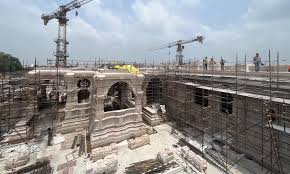Marble has been a preferred material for constructing temples for centuries. Its elegance, durability, and the ability to be polished to a high shine make it an ideal choice for sacred structures. Various types of marble are used, each with unique characteristics that contribute to the beauty and longevity of temples. Understanding the types of marble used can help you appreciate the craftsmanship and architectural choices of temple builders.
Types of Marble Used in Temples
White Marble
White marble is the most common type of marble used in temple construction. Its pure and pristine appearance symbolizes purity and spirituality. Temples made from white marble often look majestic and serene, making them perfect for places of worship. This marble is also highly durable, which ensures that the temple can withstand the test of time.
Carrara Marble
Originating from Italy, Carrara marble is renowned for its fine grain and white to blue-gray hue. It is a popular choice for temples due to its subtle veining, which adds a touch of elegance without overwhelming the design. Carrara marble is often used for intricate carvings and detailed architectural elements, highlighting the skill of the temple contractor in creating stunning temple structures.
Makrana Marble
Makrana marble is a high-quality marble found in India and is famous for being used in the construction of the Taj Mahal. It is highly durable and can retain its shine for many years. Temples made from Makrana marble exhibit a smooth, polished surface that enhances the temple’s aesthetic appeal. This type of marble is also resistant to water and weathering, making it ideal for temple construction.
Black Marble
Though less common, black marble is sometimes used in temples to create a striking contrast with other materials. Black marble adds a unique and dramatic element to temple design. Its bold color can be used for specific architectural features or decorative elements, making the temple stand out. This type of marble is often used in combination with white or other lighter marbles to create visually appealing patterns.
Characteristics of Marble in Temple Construction
Durability and Longevity
One of the primary reasons marble is chosen for temple construction is its durability. Marble can withstand weathering and environmental changes, ensuring that the temple remains intact for centuries. A temple contractor often selects marble for its ability to retain its structural integrity over long periods.
Aesthetic Appeal
Marble’s natural beauty and ability to be polished to a high gloss make it a favorite material for temples. The unique veining and patterns in marble slabs add to the temple’s aesthetic appeal, creating a visually stunning place of worship. The choice of marble can significantly influence the overall look and feel of the temple.
Workability
Marble is relatively easy to work with, allowing craftsmen to carve intricate designs and details. This workability makes marble an excellent choice for creating ornate sculptures, columns, and other decorative elements in temples. Skilled temple contractors can transform marble into beautiful works of art, enhancing the temple’s spiritual atmosphere.
Conclusion
The type of marble used in temple construction plays a crucial role in defining the temple’s beauty, durability, and spiritual ambiance. From the classic white marble to the elegant Carrara, the choice of marble reflects the architectural vision and craftsmanship of the builders. Understanding these different types of marble can deepen your appreciation for the artistry and effort that goes into building these magnificent structures. Whether you are visiting a temple or considering a temple project, knowing the qualities of different marbles can guide you in making informed decisions about temple construction.

